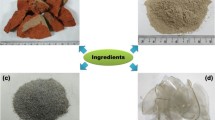Abstract
In this work, the recycling feasibility of treated calamine processing mine tailing (TCPMT) with glass wastes (GW) for the production of fired bricks is investigated. TCPMT was added into mixtures at a ratio of 0, 10, 20, 30, 40 and 50 % while glass waste was added separately for each formulation at ratios of 0, 5, 10 and 15 % of the dried mass of brick mixtures. The mixes of shale for brick (ShB), which consisted as the reference material, and both wastes were prepared, pressed, dried and fired at previously optimized temperature of 1020 °C. Physical, mechanical, environmental and durability properties of fired bricks were determined. The microstructural properties of fired bricks were investigated by scanning electron microscopy (SEM) and the total porosity was assessed according to ASTM standard. The results show that the increasing substitution proportion of ShB by TCPMT leads to an increase of the porosity and water absorption and to a decrease of flexural strength and density (lighter weight bricks). At the same time, the experiments showed that the addition of glass wastes into the mixtures enhances the mechanical properties of fired bricks. However, when more than 15 % of GW is used, a white scum constituted of a sodium sulphate appears at the fired brick exposed surface. Thus, fired light bricks with suitable physical and mechanical properties could be obtained from mixtures containing up to 30 % TCPMT and 10 % of GW.










Similar content being viewed by others
Abbreviations
- TCPMT:
-
Treated calamine processing mine tailings
- GW:
-
Glass wastes
- ShB:
-
Shales for brick
- GHG:
-
Greenhouse gas
- TCLP:
-
Toxicity characteristic leaching procedure
References
Mymrine, V., et al.: Oily diatomite and galvanic wastes as raw materials for red ceramics fabrication. Constr. Build. Mater. 41, 360–364 (2013)
Huang, S.-C., et al.: Production of lightweight aggregates from mining residues, heavy metal sludge, and incinerator fly ash. J. Hazard. Mater. 144(1–2), 52–58 (2007)
Zhang, L.: Production of bricks from waste materials—a review. Constr. Build. Mater. 47, 643–655 (2013)
Monteiro, S.N., Vieira, C.M.F.: On the production of fired clay bricks from waste materials: a critical update. Constr. Build. Mater. 68, 599–610 (2014)
Muñoz Velasco, P., et al.: Fired clay bricks manufactured by adding wastes as sustainable construction material—a review. Constr. Build. Mater. 63, 97–107 (2014)
Bories, C., et al.: Development of eco-friendly porous fired clay bricks using pore-forming agents: a review. J. Environ. Manag. 143, 186–196 (2014)
Demir, I.: Reuse of waste glass in building brick production. Waste Manag. Res. 27, 572–577 (2009)
Turgut, P.: Limestone dust and glass powder wastes as new brick material. Mater. Struct./Mater. Constr. 41(5), 805–813 (2008)
Tucci, A., et al.: Use of soda-lime scrap-glass as a fluxing agent in a porcelain stoneware tile mix. J. Eur. Ceram. Soc. 24(1), 83–92 (2004)
Dondi, M., et al.: Recycling PC and TV waste glass in clay bricks and roof tiles. Waste Manag. 29(6), 1945–1951 (2009)
Kaddami, A., REMINEX-MANAGEM, Morocco Oral communication 2013
Taha, Y., et al., Manufacturing of ceramic products using calamine hydrometallurgical processing wastes (revision process). J. Clean. Prod. (2016)
ASTM-C326, American Standard and Testing Materials, C326-03 (ASTM). Standard test method for drying and firing shrinkages of ceramic whiteware clays (2003)
ASTM-C373, American Standard and Testing Materials, C373-88 (ASTM). Standard test method for water absorption, bulk density, apparent porosity, and apparent specific gravity of fired whiteware products (1999)
ASTM-C674, American Standard and Testing Materials, C674-88 (ASTM). Standard test methods for flexural properties of ceramic whiteware materials (1999)
ASTM-C67, American Standard and Testing Materials, C 67 (ASTM). Standard test methods for sampling and testing brick and structural clay tile (2003)
US-EPA, Hazardous Waste Characteristics. A user-friendly reference document. October 2009 (2009)
Popescu, M., Simion, A., Matei, V.: Study of thermal behaviour up to 1550° of materials containing calcium sulphate. J. Therm. Anal. 30(2), 297–303 (1985)
Taskiran, M.U., Demirkol, N., Capoglu, A.: A new porcelainised stoneware material based on anorthite. J. Eur. Ceram. Soc. 25(4), 293–300 (2005)
Quijorna, N., et al.: Recycling of Waelz slag and waste foundry sand in red clay bricks. Resour. Conserv. Recycl. 65, 1–10 (2012)
Morillas, H., et al.: Nature and origin of white efflorescence on bricks, artificial stones, and joint mortars of modern houses evaluated by portable Raman spectroscopy and laboratory analyses. Spectrochim. Acta Part A Mol. Biomol. Spectrosc. 136, 1195–1203 (2015)
Shahidzadeh-Bonn, N., et al., Damage in porous media due to salt crystallization. Phys. Rev. E Stat., Nonlinear, Soft Matter Phys., 81 (2010)
Acknowledgments
This work was financially supported through the International Research Chairs Initiative, a program funded by the International Development Research Centre, Canada (IDRC) and supported by the Canadian Research Chairs Program. The authors thank also the research centre REMINEX-MANAGEM (Morocco), for the great help concerning the valuation of its by-product outcome of Calamine hydrometallurgical process.
Author information
Authors and Affiliations
Corresponding author
Rights and permissions
About this article
Cite this article
Taha, Y., Benzaazoua, M., Mansori, M. et al. Recycling Feasibility of Glass Wastes and Calamine Processing Tailings in Fired Bricks Making. Waste Biomass Valor 8, 1479–1489 (2017). https://doi.org/10.1007/s12649-016-9657-3
Received:
Accepted:
Published:
Issue Date:
DOI: https://doi.org/10.1007/s12649-016-9657-3




